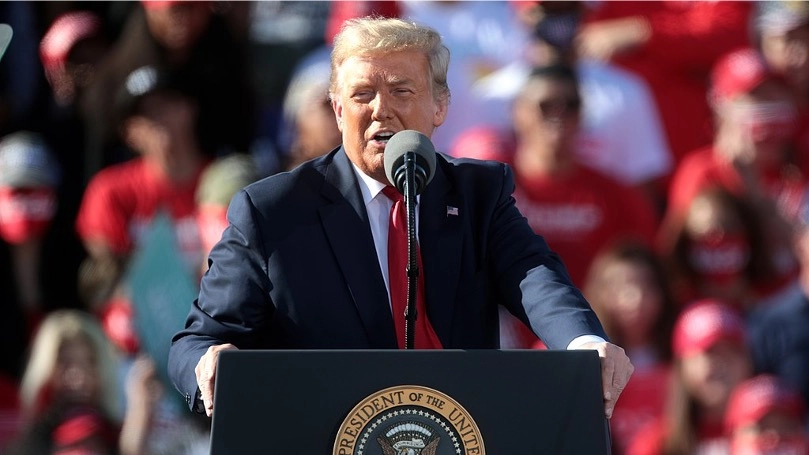Here’s What Trump’s Victory Could Mean For Rail

Photo courtesy of Gage Skidmore. Licensed under CC BY-SA 2.0
The votes are in: Donald Trump has been elected 47th President of the United States. With “Amtrak Joe” Biden exiting the White House, there could be a major shift in support for rail at the federal level. However, the Trump campaign has largely been silent on the future administration’s plan for America’s transportation infrastructure. There are some indicators, however, on what Trump’s victory could mean for the railroad industry and passenger rail moving forward.
It’s no secret that Amtrak and other passenger railroads around the country are reliant on federal dollars to subsidize their operations. Last year, Amtrak received over $2.4 billion in operating subsidies and capital grants from congressional appropriations. Amtrak had a net operating loss of over $1.7 billion in 2023, and has posted an operating loss every year since its inception. American commuter railroads and transportation agencies are similarly reliant on state and federal subsidies.
Public investment in railroads has soared over the past four years. The Infrastructure Investment and Jobs Act (IIJA, also known as the Bipartisan Infrastructure Law or BIL), included $102 billion dollars in total rail funding. The law, passed under the Biden Administration, was the largest investment in passenger rail since Amtrak was created in 1971. Major projects funded under this law include the Gateway Program in New York and New Jersey, the new Raleigh-to-Richmond passenger line, Brightline West’s high-speed line to Las Vegas, and dozens of other safety and network resiliency improvements. The law also helped fund Amtrak’s acquisition of new passenger railcars, which are being built in the United States by Siemens Mobility. The law is creating hundreds of thousands of good-paying, union manufacturing, construction, and transportation jobs.
The incoming Trump Administration can either build on this progress, or make a push to cut back on federal funding for railroads.
The transition team is still early on in the process of making cabinet picks, and Trump will likely want to focus on his most critical roles, like Secretaries of State and Defense, first. There is no clear front-runner for Secretary of Transportation right now. Trump’s Secretary of Transportation from his first term, Elaine Chao, is unlikely to return.
The first Trump administration was often skeptical of the large, federally-funded projects that passenger rail has often required to advance. In 2018, Trump encouraged Congress to oppose funding for the Gateway Program, labelling it a regional project that should be funded by the states. That effectively stalled the project during his administration.
Republican officials have traditionally opposed rail projects in favor of car-centric infrastructure like highways, and shied away from using federal funding for major rail improvements. However, the Trump/Vance win could signal a potential shift in the party’s priorities. The candidates have spent the past several months discussing their agenda to promote American manufacturing and industry. Anyone wanting to bolster American dynamism would do well by supporting the development of rail infrastructure. Pennsylvania, Michigan, and Wisconsin, three of the key swing states that pushed Trump towards victory, are some of the largest manufacturers of railroad and railcar components in the country.
While Trump has largely been quiet on specific policy around infrastructure development, he has previously praised Japan’s bullet trains and lamented the lack of these trains here in the United States.
In an August conversation with Elon Musk on X, Trump said, “[Bullet trains] go unbelievably fast, unbelievably comfortable with no problems, and we don’t have anything like that in this country. Not even close. And it doesn’t make sense that we don’t, doesn’t make sense.”
Despite Trump’s push for passenger rail funding cuts in his first term, his stance may have shifted to recognize the US has fallen behind its global counterparts in this space.
Investment in railroads is an investment in good-paying jobs for America. Continuing the momentum started by the Bipartisan Infrastructure Law, or enacting policies to encourage more private investment in railroads, would be a clear path for the Trump administration to fulfill its campaign promises to working-class constituents.
On the other hand, Trump and some of his policy advisors have indicated that they intend to defund parts of the Bipartisan Infrastructure Law. It is unclear if those claw backs would impact funding for passenger rail and railroad infrastructure projects. If it does, that would likely put Amtrak’s long-distance trains in jeopardy, similar to a 2017 budget proposal. Northeast Corridor and state-supported services could also be negatively affected by cancelled capacity and resiliency improvements.
Regardless of how the next administration decides to interface with the railroad industry, passenger rail has seen a significant increase in demand. Millennials and Gen Z are choosing the train over flying and driving for greater comfort and convenience. White House officials would be wise to focus on this trend and deliver significant gains for travelers and union workers alike.